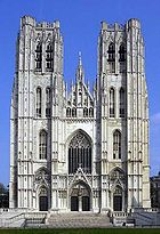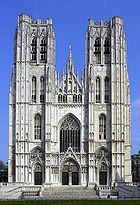
Benedictus Appenzeller
Encyclopedia
Benedictus Appenzeller was a Franco-Flemish
singer and composer of the Renaissance
, active in Bruges and Brussels. He served Dowager Queen Mary of Hungary for much of his career, and was a prolific composer of vocal music, both sacred and secular, throughout his long career.
 He was probably born somewhere in the southern portion of the Netherlands
He was probably born somewhere in the southern portion of the Netherlands
, and his approximate birthdate is inferred from a document late in his life, dated July 1558, in which he gave his age as "over 70". Appenzeller is first mentioned in cathedral records in 1518, when he is a singer, and in 1519, when he became choirmaster at the cathedral of St. Jacob in Bruges
. His several publications during the following years show that he was active then as a composer, but nothing is known of his actual whereabouts or employment until 1536, when Dowager Queen Mary of Hungary (daughter of Philip I
and Joanna the Mad
of Castile) brought him into her Brussels
chapel as a singer. By the next year he had become the master of the choirboys – the one responsible for teaching them music, and caring for them – and he was to hold this position, or its equivalent, until either 1551 or 1555.
While he spent most of this time in Brussels, he also occasionally traveled with Mary through the Habsburg
lands, as it was common for the singers of the musical chapels to accompany monarchs and members of royal families. Some of the places he is known to have visited include 's-Hertogenbosch, Augsburg
, and Munich
. Mary moved to Spain
in 1556, and at that time Appenzeller became the choirmaster at the church of Ste. Gudule
in Brussels, a post he held until the end of 1558. No records survive of his life from after that year, and he may have died shortly thereafter.
Appenzeller has sometimes been confused with two other musicians named "Benedictus", since many of his works are attributed in their sources simply to "Benedictus". Benedictus Ducis was a German composer and Protestant cleric (1492–1544), and Benedictus de Opitiis was an organist from the same region as Appenzeller. All of the works simply attributed "Benedictus" are now considered to be the work of Appenzeller.
which have survived, as well as numerous motet
s and Magnificat
settings. He also left over 40 chanson
s, many of which were published in Antwerp in a 1542 collection, Des chansons a quattre parties. The twenty-four chansons in this collection have been published as Benedictus Appenzeller: Chansons, edited by Glenda Goss
Thompson.
Appenzeller's music shows a range of stylistic influences, as would be expected in a composer working over many decades, and subject to influences from musicians coming and going from distant parts of an empire. His sacred music is typical of the Netherlandish style of the 1540s, with dense polyphonic
textures, including pervasive imitation
. He also wrote elaborate canonic structures, more in the manner of the previous generation, reminiscent of the music of Josquin des Prez
or Pierre de La Rue
. In his secular music he strove for text comprehension, and also used more repetition, for example in musical refrains, than he did in his sacred music.
Franco-Flemish School
In music, the Franco-Flemish School or more precisely the Netherlandish School refers, somewhat imprecisely, to the style of polyphonic vocal music composition in Europe in the 15th and 16th centuries, and to the composers who wrote it...
singer and composer of the Renaissance
Renaissance music
Renaissance music is European music written during the Renaissance. Defining the beginning of the musical era is difficult, given that its defining characteristics were adopted only gradually; musicologists have placed its beginnings from as early as 1300 to as late as the 1470s.Literally meaning...
, active in Bruges and Brussels. He served Dowager Queen Mary of Hungary for much of his career, and was a prolific composer of vocal music, both sacred and secular, throughout his long career.
Life

Netherlands
The Netherlands is a constituent country of the Kingdom of the Netherlands, located mainly in North-West Europe and with several islands in the Caribbean. Mainland Netherlands borders the North Sea to the north and west, Belgium to the south, and Germany to the east, and shares maritime borders...
, and his approximate birthdate is inferred from a document late in his life, dated July 1558, in which he gave his age as "over 70". Appenzeller is first mentioned in cathedral records in 1518, when he is a singer, and in 1519, when he became choirmaster at the cathedral of St. Jacob in Bruges
Bruges
Bruges is the capital and largest city of the province of West Flanders in the Flemish Region of Belgium. It is located in the northwest of the country....
. His several publications during the following years show that he was active then as a composer, but nothing is known of his actual whereabouts or employment until 1536, when Dowager Queen Mary of Hungary (daughter of Philip I
Philip I of Castile
Philip I , known as Philip the Handsome or the Fair, was the first Habsburg King of Castile...
and Joanna the Mad
Joanna of Castile
Joanna , nicknamed Joanna the Mad , was the first queen regnant to reign over both the Crown of Castile and the Crown of Aragon , a union which evolved into modern Spain...
of Castile) brought him into her Brussels
Brussels
Brussels , officially the Brussels Region or Brussels-Capital Region , is the capital of Belgium and the de facto capital of the European Union...
chapel as a singer. By the next year he had become the master of the choirboys – the one responsible for teaching them music, and caring for them – and he was to hold this position, or its equivalent, until either 1551 or 1555.
While he spent most of this time in Brussels, he also occasionally traveled with Mary through the Habsburg
Habsburg
The House of Habsburg , also found as Hapsburg, and also known as House of Austria is one of the most important royal houses of Europe and is best known for being an origin of all of the formally elected Holy Roman Emperors between 1438 and 1740, as well as rulers of the Austrian Empire and...
lands, as it was common for the singers of the musical chapels to accompany monarchs and members of royal families. Some of the places he is known to have visited include 's-Hertogenbosch, Augsburg
Augsburg
Augsburg is a city in the south-west of Bavaria, Germany. It is a university town and home of the Regierungsbezirk Schwaben and the Bezirk Schwaben. Augsburg is an urban district and home to the institutions of the Landkreis Augsburg. It is, as of 2008, the third-largest city in Bavaria with a...
, and Munich
Munich
Munich The city's motto is "" . Before 2006, it was "Weltstadt mit Herz" . Its native name, , is derived from the Old High German Munichen, meaning "by the monks' place". The city's name derives from the monks of the Benedictine order who founded the city; hence the monk depicted on the city's coat...
. Mary moved to Spain
Spain
Spain , officially the Kingdom of Spain languages]] under the European Charter for Regional or Minority Languages. In each of these, Spain's official name is as follows:;;;;;;), is a country and member state of the European Union located in southwestern Europe on the Iberian Peninsula...
in 1556, and at that time Appenzeller became the choirmaster at the church of Ste. Gudule
St. Michael and Gudula Cathedral
The St. Michael and St. Gudula Cathedral is a Roman Catholic church at the Treurenberg hill in Brussels, Belgium. In French, it is called Cathédrale Saints-Michel-et-Gudule and in Dutch Sint-Michiels- en Sint-Goedelekathedraal, usually shortened to "Sint-Goedele".In 1047, Lambert II, Count of...
in Brussels, a post he held until the end of 1558. No records survive of his life from after that year, and he may have died shortly thereafter.
Appenzeller has sometimes been confused with two other musicians named "Benedictus", since many of his works are attributed in their sources simply to "Benedictus". Benedictus Ducis was a German composer and Protestant cleric (1492–1544), and Benedictus de Opitiis was an organist from the same region as Appenzeller. All of the works simply attributed "Benedictus" are now considered to be the work of Appenzeller.
Music and influence
Appenzeller wrote six massesMass (music)
The Mass, a form of sacred musical composition, is a choral composition that sets the invariable portions of the Eucharistic liturgy to music...
which have survived, as well as numerous motet
Motet
In classical music, motet is a word that is applied to a number of highly varied choral musical compositions.-Etymology:The name comes either from the Latin movere, or a Latinized version of Old French mot, "word" or "verbal utterance." The Medieval Latin for "motet" is motectum, and the Italian...
s and Magnificat
Magnificat
The Magnificat — also known as the Song of Mary or the Canticle of Mary — is a canticle frequently sung liturgically in Christian church services. It is one of the eight most ancient Christian hymns and perhaps the earliest Marian hymn...
settings. He also left over 40 chanson
Chanson
A chanson is in general any lyric-driven French song, usually polyphonic and secular. A singer specialising in chansons is known as a "chanteur" or "chanteuse" ; a collection of chansons, especially from the late Middle Ages and Renaissance, is also known as a chansonnier.-Chanson de geste:The...
s, many of which were published in Antwerp in a 1542 collection, Des chansons a quattre parties. The twenty-four chansons in this collection have been published as Benedictus Appenzeller: Chansons, edited by Glenda Goss
Glenda Goss
Glenda Goss is an author and music historian whose special interests are music and culture, early modernism, critical editing, and European-American points of cultural contact...
Thompson.
Appenzeller's music shows a range of stylistic influences, as would be expected in a composer working over many decades, and subject to influences from musicians coming and going from distant parts of an empire. His sacred music is typical of the Netherlandish style of the 1540s, with dense polyphonic
Polyphony
In music, polyphony is a texture consisting of two or more independent melodic voices, as opposed to music with just one voice or music with one dominant melodic voice accompanied by chords ....
textures, including pervasive imitation
Imitation (music)
In music, imitation is when a melody in a polyphonic texture is repeated shortly after its first appearance in a different voice, usually at a different pitch. The melody may vary through transposition, inversion, or otherwise, but retain its original character...
. He also wrote elaborate canonic structures, more in the manner of the previous generation, reminiscent of the music of Josquin des Prez
Josquin Des Prez
Josquin des Prez [Josquin Lebloitte dit Desprez] , often referred to simply as Josquin, was a Franco-Flemish composer of the Renaissance...
or Pierre de La Rue
Pierre de La Rue
Pierre de la Rue , called Piersson, was a Franco-Flemish composer and singer of the Renaissance. A member of the same generation as Josquin des Prez, and a long associate of the Habsburg-Burgundian musical chapel, he ranks with Agricola, Brumel, Compère, Isaac, Obrecht, and Weerbeke as one of the...
. In his secular music he strove for text comprehension, and also used more repetition, for example in musical refrains, than he did in his sacred music.

